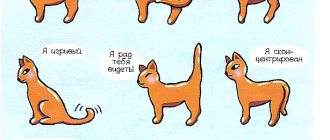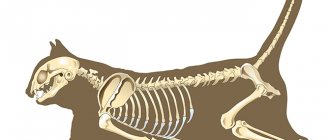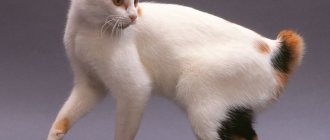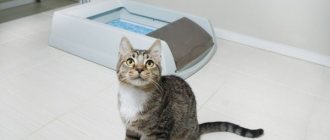Pets bring us a lot of joy, but they also need constant care. The health and well-being of a cat depends entirely on its owner. Sometimes it happens that people do not understand what is happening to their furry pet. For example, why does he walk around the house with his tail between his legs? If there is something alarming about your cat's behavior, contact a veterinary clinic for advice.
Fracture or dislocation
The cat's tail is part of the spine. It consists of bones, so sometimes dislocations and even fractures of this part of the body occur. This happens, for example, if an animal falls from a height or gets its tail pinched by a door.
Watch your pet carefully. If he does not sit down completely, but holds his tail between his paws, this means that the animal is experiencing pain. Damage to the spine is fraught with serious irreversible consequences, because the spinal cord also suffers. Therefore, immediately take the injured four-legged animal to the veterinarian for examination. Only a specialist will be able to establish an accurate diagnosis using x-rays and prescribe the necessary treatment in a timely manner. You won't be able to help your pet on your own.
Injury
If a cat's tail hangs, you need to remember what the animal did shortly before. Most often, this results from an injury received during an unsuccessful landing. Also, the tail could have broken from being severely pinched by a doorway.
You can check the fracture yourself. To do this, you should observe the animal. A curled tail in cats will hurt and cause discomfort.
If there is a fracture, the problem will have to be solved by simply waiting. The fracture can be fixed with a special bandage or plaster. In some cases, your veterinarian may prescribe an antibiotic and anti-inflammatory medication.
If an x-ray does not reveal a fracture, but the problem began after a fall, a specialist will diagnose a bruise. It will take time for a hanging tail to recover.
Problem with nerve endings
During the period of active growth, cats sometimes experience disturbances in the development of the spine. This leads to pinched nerve endings and increased muscle tone. Then the animal cannot fully control its tail, and is not even able to lift it.
It happens that disorders affect the entire musculoskeletal system. Such pets experience underdevelopment of the chest or curvature of the paws. A nerve rupture may also occur due to injury: for example, a strong blow to the back.
Why doesn't my cat's tail move?
As mentioned, whether to keep your cat's tail high and proud or low and harmless should be a conscious decision. The tail should at least twitch and change position. What does it mean when a cat's tail doesn't move? Often a completely immobile tail is a sign of injury.
This could be a tail or lower back injury, such as a dislocation or fracture. It may also be due to nerve damage. There are tests you can run to see if your cat is able to move its tail. This includes:
- Look for signs of physical damage to your cat's tail . Swelling at the base is a common symptom.
- Stroke the cat from head to tail . Cats with pain at the base of the tail will not respond well to being touched in this area. Expect to be scratched or hissed.
- Play with the cat . This should show the natural movement of the tail as part of the interaction.
Severe stress
A cat's tail between its legs indicates that there is some kind of problem. Sometimes it is not physical, but psychological in nature. Pets are susceptible to emotions, just like people. Pets have a hard time being separated from their owner, visiting a doctor, moving to a new place of residence, and other similar events.
If an animal is afraid or has experienced severe stress, then such problems often manifest themselves with just such a symptom. When a domestic cat suddenly gets outside for the first time, she will behave this way. In this way, she tries to protect the abdominal area and vital organs. Try to show your frightened pet your love and care so that he can more easily overcome the shock.
Emotional factor
Emotional factors should be highlighted separately:
- First of all, it is a state of aggression. With its tail tucked, the pet feels protected. The animal also whips itself on the sides with the tip of its tail for a larger radius of protection;
- in a state of fear, the pet tries to shrink as much as possible. A female individual can thus protect offspring from possible danger. Numerous beatings and fights also intimidate the cat, as a result it shrinks into a ball;
- During sleep, the animal curls up into a ball. This is considered the most comfortable and protected resting position.
Brain hemorrhage
Older felines, just like people, are susceptible to strokes. When a cerebral hemorrhage occurs, some of the brain cells, neurons, die due to poor circulation. There is also an ischemic form, when the vessel does not burst, but is clogged with a blood clot or cholesterol plaque. Both types of stroke often lead to paralysis of one or more limbs in the animal, depending on the severity of the case.
The tail may also remain motionless. By the way, castrated individuals are more often susceptible to this problem, which is facilitated by weight gain and low physical activity. The rehabilitation process takes time, and the animal is not always able to cope with the negative consequences of the disease.
- Author: Elena Romanenko
Rate this article:
- 5
- 4
- 3
- 2
- 1
(1 vote, average: 5 out of 5)
Share with your friends!
Nerve rupture
If a cat's tail hangs after a collision with another animal, then there is a possibility of a nerve rupture. If this happens, the pet will not only not be able to control part of the body, but its tail will not respond to external stimuli.
Doing anything on your own is useless. You can't do it without qualified help. The damaged tail will most likely need to be amputated to prevent complications.
When should you sound the alarm?
Reasons why a cat lowers its tail:
- A strong blow or fracture can cause the cat to not raise its tail.
- Damage to nerve endings is also a possible problem. It is impossible to start treatment, since this organ is an extension of the spine and its integrity is necessary for full-fledged work.
- Stroke - if the animal is of advanced age, this will cause the cat to have a hanging tail . In this case, the veterinarian will prescribe antibiotics that will return the tail to its normal position in whole or in part. But relapse can happen again.
- Nerve problems - living in stressful conditions. For example, if a cat is oppressed, often beaten, or he is simply not yet accustomed to new owners who have just adopted a new four-legged friend, then he will behave nervously. At such moments, you should not rush to establish a connection with the cat, because good relationships are formed over time, when the animal gets used to the new environment.
- Safety of your offspring. It’s not uncommon for cats to want to protect kittens from exposure to humans or other dangers. This often happens if a pregnant cat does not have her own secluded place where she can safely give birth and raise her offspring. Until the time comes, she will walk from corner to corner with her tail lowered, and look for a suitable option.
- Hereditary predisposition. Often, after crossing different breeds, kittens with deformities are born. Most often, such a developmental deviation does not cause discomfort.
- If the animal is tired, then this position will be a characteristic feature. In this case, the cat needs to be allowed to sleep and rest.
Almost all symptoms will be accompanied by a lack of appetite and unusual behavior.
Pets bring us a lot of joy, but they also need constant care. The health and well-being of a cat depends entirely on its owner. Sometimes it happens that people do not understand what is happening to their furry pet. For example, why does he walk around the house with his tail between his legs? If there is something alarming about your cat's behavior, contact a veterinary clinic for advice.
Symptoms and treatments
If the cat cannot lift its tail, then the owner needs to examine his pet for possible injuries. Associated symptoms should be identified: convulsions, trembling, tail tucked to the stomach, low body temperature. If your blood sugar level drops, your pet will look scared and depressed. This condition is extremely dangerous for the animal. Within a few hours the cat dies. Hypoglycemia is very often diagnosed in purebred individuals. Lack of hemoglobin in the blood develops anemia. The condition leads to insufficient oxygen exchange in tissues and organs. Oxygen starvation develops. An allergic reaction may be accompanied by excessive salivation, swelling of the mucous membranes, and vomiting. In this case, you can help the animal with the help of antihistamines prescribed by the veterinarian. Injuries, fractures, and bruises can only be corrected by a specialist, since all damage can affect the spinal cord. Treatment is carried out only in a clinical setting.
Causes
It is very important to detect a pet’s health problem in a timely manner. If a cat cannot sit down and tucks its tail between its legs, then we can conclude that this is painful for it. In this case, immediate contact with a veterinary hospital is required. Since the tail is part of the spine, injuries or diseases can lead to irreversible consequences. Some of the reasons why a cat has a drooping tail include the following:
- Congenital malformations. It is most often found in artificially bred cats, as well as among those who like to cross their pet with noble breeds. Mutations in a number of purebred animals are quite a common occurrence, because owners first of all strive to get a beautiful creature, without worrying about compatibility at the genetic level. Therefore, it happens that cats from birth are not able to raise their tail, which significantly complicates the normal functioning of cats. In some cases, kittens have a raised tail, but by a certain age it droops. This also indicates problems in the development of the spine;
- Spinal fusion. If the cat has a drooping tail, but until a certain point such problems were not observed, then the pet may have fused the vertebrae. As a result of improper development, a hallux of the caudal region is diagnosed. This is the most common cause of sagging of part of the spine among cats after reaching a certain age. When two vertebrae fuse, tension occurs and atrophy of muscle tissue and tendons develops;
- Vertebral displacement. Active animals can damage the caudal spine during play or during fights with other animals, which will lead to displacement. As a result, the cat simply cannot lift it for physical reasons, the pain of the injury;
- Growing too fast. Active development of the spine can lead to pinched nerves and muscle tone. Such disorders affect the entire spinal column. Some individuals grow up with curved front legs, increased neck muscle tone, and an underdeveloped chest;
- Diseases such as hypoglycemia, anemia. It is especially common in purebred individuals.
Tail kinking (fusion of vertebrae) in most cases does not cause pain. Therefore, an animal at home can adapt to living without the instrument of balance and communication. You simply cannot survive in the wild with such a deviation.
Stroke
Cats who are many years old may lose their tail due to a stroke. In this case, the veterinarian will prescribe restorative therapy. She can help and the tone of the tail is fully or partially restored. However, the problem may happen again.
The tail in cats is one of the important parts of the body; it is a full-fledged part of the spinal column. With its help, the animal maintains balance and communication. If your cat has a drooping tail, this is a clear sign of a health problem. If such a phenomenon is detected, it is necessary to carefully examine the pet and determine the accompanying symptoms, if any. Behavior and appearance play an important role. Lethargy and lack of former activity indicate malaise. Ungroomed fur indicates the animal’s inability to clean itself, as well as problems with the oral cavity (the main tool for washing is the tongue; if there is a problem with the organ, cats stop licking the fur, and it takes on a wet and unkempt appearance).











